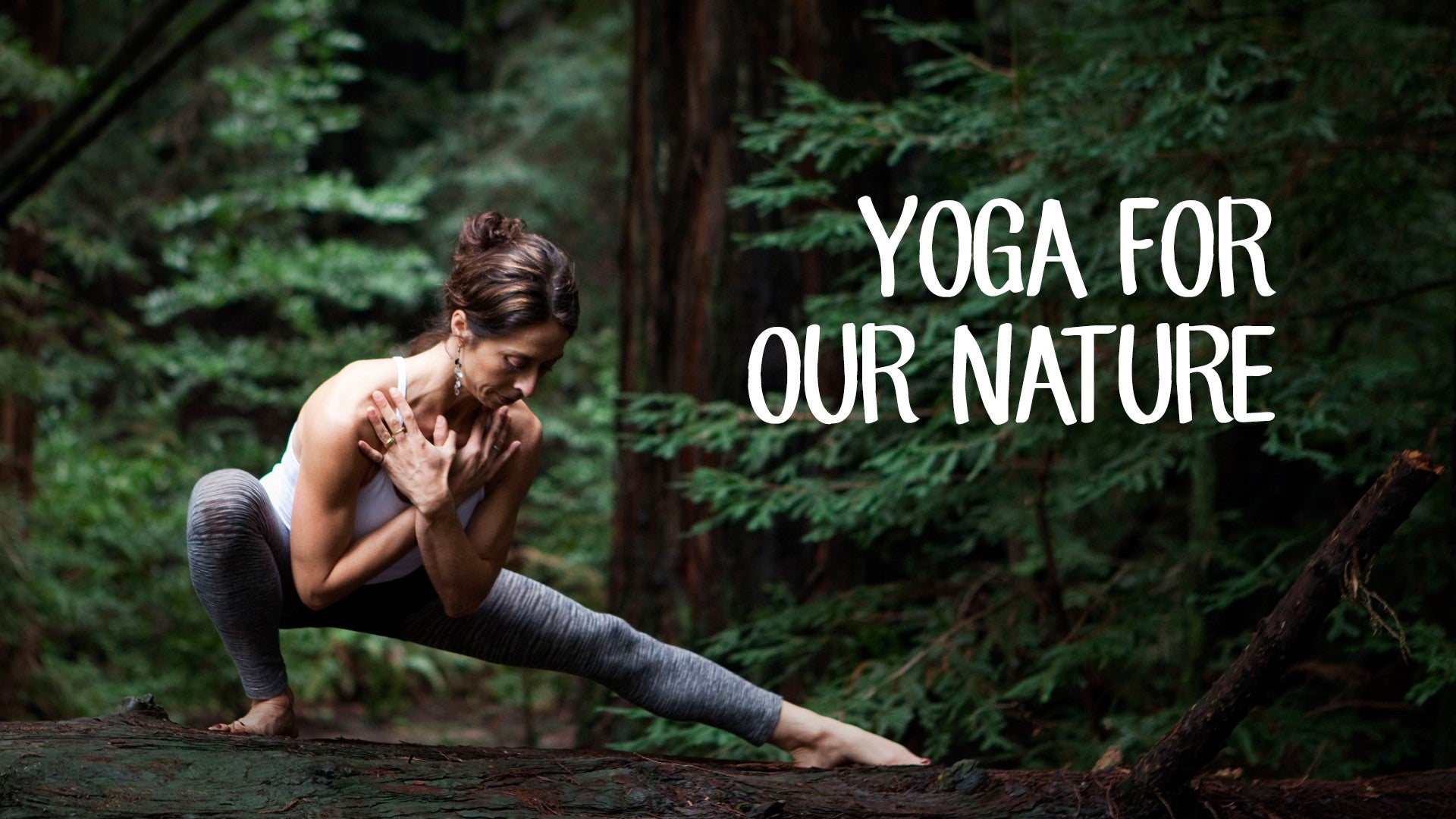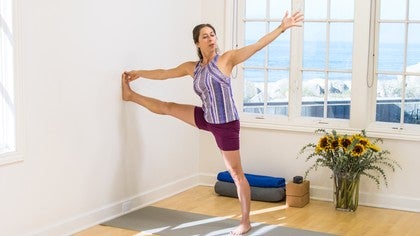Description
About This Video
Transcript
Read Full Transcript
Hello and welcome to Get to Know Your Dosha Talk. This will be an overview, a lecture to pique your curiosity a little bit more about the doshas. The doshas are made of the five elements, and the five elements are ether, air, fire, water, and earth. The doshas are a combination of two elements, so for example, Vata is a combination of air and ether, or space. Pitta is a combination of fire and water.
And Kapha is a combination of earth and water. We're each born, the moment you're conceived is when your Prakruti, your yogic DNA is determined, and then you start living life, separate from being nourished by your mother, and we start to notice different kinds of tendencies, imbalances, based on the unique combination of elements that we were born with. So for example, my unique constitution is Vata three, which means it's the highest, Pitta two, second, and Kapha third. So for me knowing what my constitution is, what my doshas are, I try to create a lifestyle that keeps them in balance for my unique constitution. So when they're in balance, they serve to protect me, and when I live in a way that might be out of balance, where one of the doshas enlarge potentially, I start to feel different, and my body responds in different patterns.
So since I'm a Vata, number three, this means when I'm out of balance, I will tend to experience more insomnia, more restlessness, I'm more indecisive, and that's not normally who I am, but when I'm out of balance, that's what I see. So what I try to do is know this about myself. That's how I go to balance. And I create a life that includes regular oil massages, that involves eating lots of soup, to spend time each week with silent mornings to help me balance my nature when I'm out of balance by being too busy, by moving too fast. And so yours will probably be different than mine of course, but just so you have an example, we use this knowledge of the doshas to help design a lifestyle practice that keeps us in balance knowing where our tendencies towards imbalances go, so it's really a preventative healthcare system more than a curative healthcare system.
So let's talk a little bit more about each dosha. So Vata by nature is light, cool, and dry, and what I mean by light is the opposite of heavy. Vatas tend to like movement a lot, and oftentimes to the extreme where that's where they go out of balance. They're also very involved in communication, and that's one of the expressions of Vata is communication. When out of balance, Vatas will tend to experience, as I mentioned, insomnia.
They might experience dry condition in the body like constipation, and they might also just notice much more dry skin overall in the body. So ways that we balance the Vata constitution, and this is a short list, is to establish routine. Going to bed at the same time every day, waking up at the same time every day. It's a really important step for stabilizing Vata. We also add in practices of slowing down to eat warm, nourishing foods, and basically soup, I'd say, would be the best medicine for a Vata person because you have to usually sit down to eat your soup, it's kind of difficult to drive around and multitask and drink, eat your soup.
So soup slows us down, it's hydrating, which is good for the dry nature of Vata, so soup is really great, routine is really great, oil massage is really great, that you give to yourself or if you can splurge and get oil massages with people where you live, I highly recommend that as a way to stay in balance for the Vata constitution. In our asana practice, we want to invite you to go slower in your movements, to do less repetitions. If somebody's suggesting eight repetitions, maybe you do four really slowly with your breath, and that would be one way to reduce the air element in the body if you've got too much air element that's really stimulating you. And we wanna use things like the wall and props to help you feel physically more stable and to actually hold you, and bring that earth quality towards your bones to make you feel, again, a little bit more inwardly focused if your energy is all out here. So props are a great way to help you feel a little bit deeper into your practice.
Those are few of my favorite ways. One of the ultimate poses you could do for Vata balancing in the asana land is to be in Shavasana with sandbags over your ankles and over the front of your pelvis, so just get a sense that you invite the heavy quality to your practice, and that would be one day to balance the Vata. And as we open up the conversation now of Pitta, so Pitta's nature is hot, intense, sharp, and bright. Those are a few words to describe Pitta. Pittas seek knowledge, Pittas, or Pitta, is the transformational quality, the fire that is essential for us to take things in from the outside through our senses, to transform whatever we take in, to become our body.
So for example, we eat food from the outside world. We are able to digest, which is such a miracle, food from the outside to build new tissues, to build your new body. So that transformational process is Pitta's role, it's that fire and that spark that makes that happen. So Pitta is about transformation, it's the digestive essence in the body. To get too much heat in your system can create its own imbalances.
So when someone has too much Pitta in their system, they often have more red rashes, red skin starts to appear, with the extra heat they might notice more loose stool in the body. They might also notice more sudden bursts of anger or impatience, maybe even an increase of blood pressure. Those would be just a short list of high Pitta conditions when we're out of balance. And then to get Pitta into balance, the most important word to embrace is relax, which is not gonna be easy for Pitta to digest, but to really consider that word, to take it to heart whenever you start to feel stressed or upset or angry about something, to take a moment to reflect on that word, relax. Again, I promise it won't be easy to do, but it'd be a great word to try to get more comfortable with because it's the opposite of intense behavior, it's the opposite.
So how can we calm ourself down, how can we relax around all matters? And one of the ways that we can start to relax more is by taking in a few deep, slow breaths, just to get potentially connected to actually what it is that you're feeling, so then you can know how to identify, how to potentially resolve, the emotional issue. First you have to know what you're feeling. So that's a great step for the Pittas, to breathe, identify what we feel. Also if you have the opportunity to go jump in the ocean, or to put your feet, if you don't have an ocean nearby, in some cold water, so that you bring the temperature of the body down, and you bring the energy and awareness away from your head, which might be feeling like it's about to explode with too much Pitta, and you start to cool down with feet in the water, or jump in the ocean, jump in the river if you live near a body of water.
We also want to mindful of trying to decrease any inflammatory kind of foods that you eat including nightshades, including maybe all the processed foods in the middle of the grocery store aisles, and maybe decreasing the sugar and alcohol consumption while you have an inflamed condition in the body 'cause the alcohol acts a little bit like a lighter fluid which makes things get even hotter and more intense, which leads to burnout, which leads to more exhaustion. So we wanna try to avoid that path and instead embrace practices that are a little bit less competitive, that are less intense. So instead of going to the level four vinyasa class, go to a basic class, a vinyasa flow, versus going to a class that's all about doing your poses right wrong, try to embrace sort the middle path a little bit more with playful movements, creative flows, maybe be on the ground more to receive that cooling energy of the earth, and let go of trying to do it right, or let go of knowing how to do things a certain way, and embrace a little bit more of the mystery of what's possible on the other side of you knowing what's right. So kind of our lens of the world expands in that way in maybe a fun, lighthearted way. And those would be a few of the examples of how to decrease the Pitta nature with our asana practice, as well as maybe doing the left nostril breathing, which is more of a cooling practice, and you'll have to try that out for yourself to experience the benefit of that maybe for one minute up to five minutes of blocking right nostril, breathing through the left.
Just an additional tool to use to cool down your Pitta. Okay let's talk about Kapha now. So Kapha's nature is cool, slow, and heavy, much like the earth, very needed in our culture, very needed in our body to provide stability. Kapha also provides lubrication, which allows for free-flowing, easy movements in your body and your joints. Kapha is in general we would say, compassionate.
There's a loyal quality often to the Kaphas. There's an endurance quality that the other two doshas don't have that Kapha has. So Kaphas would be like the marathon runners versus the Vatas would be like the sprinters. So if we think of the Kaphas as the ones that have this long endurance, they're the type of constitution or person that would ask how can I help? Which is really nice to have around.
So we all ideally hopefully have a best friend that's a Kapha, or maybe your partner's a Kapha, and that would often lead to lots of ease in your life when you're around a bunch of Kaphas. So as we see them as a nourishing constitution, it almost can be at their expense, so they might be more concerned how you're doing and not take the best care of themselves. So when a Kapha is out of balance, oftentimes what we'll notice is a little bit more dullness, poor circulation, potentially swelling in the body, weight gain is another downside of a Kapha that's out of balance. So ways that we try to bring Kapha back into balance is number one, is through exercise. And I do mean exercise on a daily basis, so Kapha has generally the need to sort of stay engaged physically all the time to keep the warmth and the heat necessary for good circulation.
So they don't really get like a day off, or it's just a little bit of exercise every day, but generally you're doing enough to feel warm, to break a sweat. And that's what I think is one of the most important things. Ideally exercise outside, so you also get the benefit of that vitamin D and getting that sunlight and fresh air. So exercise is super important. The other thing is warm foods and drinks.
So something like ginger tea is great. It's warming, it'll help improve circulation. And when it comes to eating food, one of the most challenging things for Kaphas is they have such low burning digestive fires that it's important not to put too much food in at one sitting for Kaphas. So if you eat out or you eat in, a normal portion ideally is like one bowl-size to get to you to the point where you have no more hunger. For Kaphas, since their appetite is usually low, they might only need to eat about this much of that portion to feel satisfied, so for Kaphas to feel light and to have good circulation really need to be careful how much they eat in one sitting.
And that is challenge to do every single day, so it's to me one of the more challenging constitutions because we can tend to overeat every day multiple times if we're not really careful and paying attention. So being aware of how much you eat can help protect your digestive fire so that what you take in digests quickly and efficiently, that would be an ideal. So exercise, eating in the right proportion, warm intake of foods, not having cold things come in because the sutra like increases like, opposites balance or decrease. So if my constitution is cold, and I bring in a bunch of cold things, it makes my system cold, my digestive fire might not work as efficiently, might not be very bright, and I might feel more tired, lethargic after I eat because of that, okay? So we're trying to stay with the warm side of things.
I also think for the asana practice engaging in dynamic, fluid movement is the most important type of asana practice to do. Ideally in the morning time and the later evening time, maybe even both times a day a little bit to get the circulation going before you bring food into your body. That's why I think morning and evening's important. So a typical sun salutation is an example of a dynamic, fluid moving practice that builds some of that heat. And you can be very creative with other versions of that, but that's an example of what kind of asana's great to do.
Keep your eyes open, move quickly, so eyes are open to catch the light, looking toward the sky to open the chest, and things like that will typically help to keep your energy high, your spirits high if you've got some excessive earth or water tendencies right now. So the asanas are really helpful to balance the Kapha dosha. So now that we've taken in a little bit of information of the profiles of the three doshas, you might notice that you resonate or relate to one more than others. And I often describe the one that you feel most comfortable with as the driver. So let's say you're gonna go on a road trip, and whatever your normal tendency is, that's the driver.
Mine is Vata, is the one I most relate to, so Vata's in charge of most of the driving on the road trip. And at some point I might feel fatigue from sitting too much, from driving too long, and I get tired and exhausted, and when I feel fatigue in that way, I'm not like myself, my normal self, then I start to see who's in my passenger. And my passenger happens to be Pitta, so that's the dosha I feel also connected to, and what that means now I'm tired, I start to see different sides of myself. I see the cranky, irritable, impatient side of myself, and that's not how I normally am, but when I'm tired, I get to see that side of myself, and that's when I know I'm kind of getting out of balance 'cause I'm getting more critical and judgmental, all those Pitta qualities. And then I also know that I have the third dosha as part of my constitution, and so Kapha for me is in the backseat.
It's always there, maybe it's sleeping, it doesn't need a lot of attention, but it's there. So I'm aware that my normal state is the Vata that loves the space of a road trip, and then there's a time of fatigue, and I need to see who my second dosha is, and then I try again to take a break, get more rest, to stay more in my Vata constitution. So Pitta showing me its face helps me realize ooh, I'm getting out of balance. So I wanna decrease my movement, pull over, take a rest, hydrate, do things that are good for Vata to find my balance. So maybe knowing this about yourself, kind of ask yourself maybe the question, what is your normal state of balance, who's normally driving the vehicle of your body, and what does it look like for you, which dosha do you see when you're fatigued, when you get sick, what are the tendencies, what do they look like, and then doing your best to try to stay with the profile of the driver's seat constitution.
In the series, we've created different asana classes to help balance the constitutions, so we've created classes to slow down your Vata for those times when you feel like you're rushing, you're moving too fast. We've created classes to help soothe and cool down your Pitta for stages of life or days or weeks where you feel really stressed out. And we've made some classes that are core-engaging to rock your Kapha, to increase your core temperature, to get you going if your energy feels a little dull or a little bit low. And as you may have recalled if you watched the previous seasons, that season two talks a little bit more about the seasonal aspects of the doshas and how Vata is in charge of that fall transition, of the winter into spring transition. How Pitta is what's ruling the summer season, and how Kapha is often at the heart of our winter practice.
So it's nice to see that we have our unique constitution related to the doshas, that nature is related also to the doshas, and that different stages of life, which might be a whole other conversation, are also related to the doshas. So the best way to actually determine your constitution is to visit a local practitioner. And if you don't have a local Ayurvedic practitioner where you live, you can go online, and a use a few resources to take your dosha test. There's Banyan Botanicals' site, doctorblossom.com, Dr. Claudia Welch, all have great information, very user-friendly, often lead you back to Banyan Botanicals' site. And you can check out what's my current, out of whack, where am I out of balance state, and they have lots of great remedies and solutions and herbs and ideas for how to keep you back in balance.
So I hope you have fun exploring your nature through these tools in season three for the doshas. You can go back to season two to learn a little bit more about lifestyle and seasonal practices, and you can go all the way back to season one to learn all about the basic elements again, which I appreciate going back to again and again, 'cause they're, again, at the core of what makes your dosha, your potential imbalances, or potentially your stability. So I wish you much health in the seasons ahead. Thank you so much for watching Yoga for Our Nature. Namaste.
Yoga for Our Nature: Dosha Jam
Comments
You need to be a subscriber to post a comment.
Please Log In or Create an Account to start your free trial.










